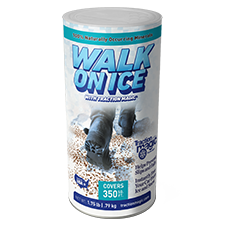Long-Lasting Frost-Proof Concrete Driveway

Just because it’s summer doesn’t mean you can’t start thinking about your winter. Chances are, if you live in a cold city, you’ll have to deal with a few months of freezing temperatures and snow on your concrete driveway. Yes, it can be a pain, but there are some simple steps you can take to ensure that your new driveway doesn’t crack or crumble apart as soon as a little bit of ice and frost hits it. And if you ever wonder, can you use ice melt on your roof? Then you will get your answer in this article.
Concrete is a versatile and commonly used construction material, but it’s not immune to the effects of frost and freezing temperatures. Frost can lead to serious damage in concrete structures, affecting both their appearance and structural integrity. In this article, we’ll delve into the world of frost-resistant concrete, its benefits, and how to protect your concrete surfaces during winter. Additionally, we’ll introduce Safe Thaw, an innovative ice melt solution that complements frost-resistant concrete while ensuring safety for people, pets, plants, and surfaces.
Long-Lasting Frost-Proof Concrete Driveway: Tips and Best Practices
A frost-proof concrete driveway is essential for homeowners in colder climates. Freezing temperatures and frost heave can damage concrete surfaces, leading to cracks, uneven surfaces, and costly repairs. By understanding the challenges posed by frost and implementing proactive measures, you can ensure your driveway remains durable for years to come. This guide explores the causes of frost damage, the right materials to use, and essential maintenance practices for a long-lasting, frost-resistant concrete driveway.
What Does Frozen Concrete Look Like?
Frozen concrete often appears discolored, dull, or chalky. It may have surface cracks or show signs of spalling, where small pieces of concrete break off from the surface. These visual cues can indicate that the concrete has been affected by freezing temperatures.
How Does Frost Affect Concrete?
Frost affects concrete through a process known as freeze-thaw cycling. When water within the concrete freezes, it expands and exerts pressure on the concrete matrix. Upon thawing, the ice melts, leaving voids that compromise the concrete’s strength and durability. This cycle of freezing and thawing can lead to cracking, spalling, and overall deterioration.
Understanding Frost Heave and Its Impact on Driveways
Frost heave is one of the leading causes of driveway damage in regions with freezing temperatures.
What is Frost Heave?
Frost heave occurs when water in the soil beneath a driveway freezes and expands. This expansion exerts upward pressure, causing the concrete surface to lift or crack. When the ice thaws, the ground settles unevenly, leading to further structural instability.
Common Signs of Frost Heave Damage
- Cracks: Visible fractures on the surface of the concrete.
- Uneven Surfaces: Sections of the driveway may lift or sink.
- Scaling and Spalling: Surface flaking caused by freeze-thaw cycles exacerbates frost heave damage.
Long-Term Effects
If not addressed, frost heave can lead to significant structural damage, requiring costly repairs or even full driveway replacement. This is why ensuring proper construction and maintenance is critical to mitigating its impact.

What Is Frost Damage in Concrete?
Frost damage in concrete refers to the deterioration caused by the repeated freeze-thaw cycles. The damage can manifest in the form of cracks, scaling, surface pitting, and loss of structural integrity.
What Is Frost Resistant Concrete?
Frost resistant concrete is specifically designed to withstand the effects of freeze-thaw cycles. It contains air-entraining agents that create microscopic air bubbles within the concrete, providing space for water to expand and contract without causing damage.
Not All Concrete is Suitable For Driveways
Concrete can crack if it is exposed to frost. Concrete expands and contracts as it freezes and thaws. This process causes the concrete joints to open up, which can lead to cracks in the surface of your driveway. Alternatively, if your driveway is too thin, there won’t be enough material around the edges to support itself under its own weight once it’s installed.
Build Up Thicker Concrete: As with any driveway, it’s important to build up your concrete so it’s thicker than normal where the frost can get to it. The best way to do this is by using a thick layer of aggregate in addition to your normal mix of cement and sand. This will ensure that your drive has a nice smooth surface while still being protected from cracking or crumbling due to frost.
Reinforce Your Concrete: If you can, reinforce your concrete. Use:
- Reinforced concrete that has rebar or steel mesh.
- Concrete that has a higher cement content
- Concrete that has a higher water content
- Concrete with more sand in it and less gravel/stone.
Don’t Allow The Water to Pool Anywhere: Firstly form and pour your concrete so that the water doesn’t pool anywhere. If there’s a low spot in your slab, fill it with some kind of material that will allow the concrete to bond well with it (like sand or cement). It also helps prevent frost damage by keeping cold air from seeping into the ground through cracks at night.
Use Insulation Materials in The Slab: As you build your concrete, use insulation materials in the slab, such as Styrofoam or cardboard tubes. Insulation can be done by building a frame and placing it over it. You can also place old clothes, blankets, and newspapers under the concrete to keep it from freezing. Old furniture and books are other options for keeping the heat in your new driveway.
Selecting Appropriate Concrete Mixes for Cold Climates
The type of concrete used for your driveway plays a significant role in its ability to resist frost damage.
Importance of Water-Cement Ratios
Concrete with a low water-cement ratio is less permeable, reducing the risk of water infiltration. This makes the driveway less susceptible to freeze-thaw cycles and the subsequent formation of cracks.
Use of Air-Entraining Agents
Air-entraining agents introduce tiny air bubbles into the concrete mix, which act as pressure-relief chambers. These bubbles allow expanding water to escape, reducing the likelihood of cracking during freezing temperatures.
How Thick Should Driveway Concrete Be?
For residential driveways, the recommended how thick driveway concrete is 4 to 6 inches. Thicker concrete provides greater strength and durability, especially in areas prone to frost heave. Reinforcement with rebar or wire mesh can further enhance stability.
Importance of Proper Drainage Systems
Water management is crucial for preventing frost heave and prolonging the life of a concrete driveway.
Preventing Water Accumulation
Standing water can seep into the soil beneath the driveway, increasing the risk of frost heave. A well-designed drainage system ensures that water is diverted away from the concrete surface and its base.
Sloping and Grading
Ensure the driveway is properly sloped to direct water runoff away from the surface. The slope should ideally be 1/4 inch per foot to prevent pooling.
Installing French Drains
French drains are effective solutions for redirecting water away from the driveway. These systems use perforated pipes buried in gravel-filled trenches to channel water into appropriate drainage areas.
Regular Maintenance Practices for Frost-Proof Driveways
Routine maintenance is essential to protect your driveway from frost-related damage and extend its lifespan.
Sealing Cracks
Inspect your driveway regularly for cracks and repair them promptly. Use high-quality sealants to fill cracks and prevent water infiltration, which can exacerbate frost heave.
Applying Protective Sealants
Applying a protective sealant to the concrete surface creates a barrier against moisture and deicing chemicals. Reapply sealants every two to three years for optimal protection.
Timely Snow Removal
Remove snow promptly after a snowfall to prevent ice formation. Use plastic-edged shovels or snow blowers to avoid damaging the surface. Avoid traditional salts and instead use ice melt on concrete products that are chloride-free and safe for concrete.
Regular Cleaning
Keep your driveway clean by removing debris, dirt, and any residual deicing agents. Use a mild detergent or pH-neutral cleaner to avoid damaging the concrete surface.
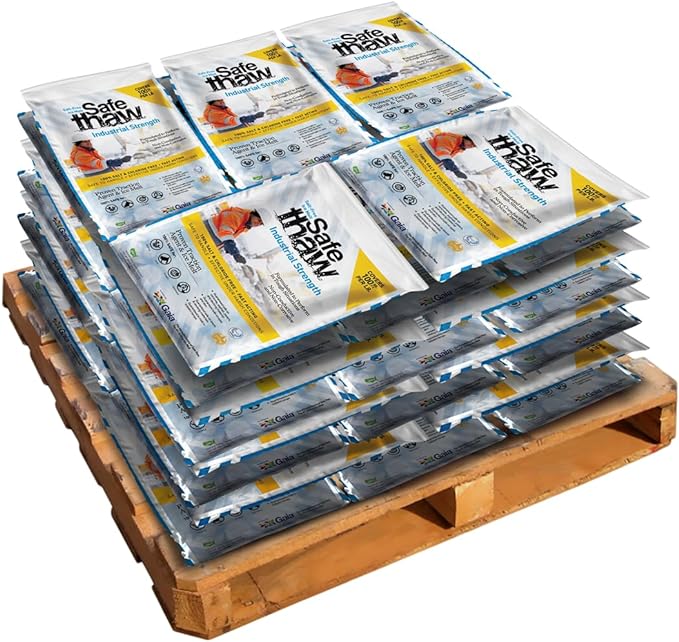
40 Bags
Safe Paw Thaw Industrial Strength Salt-Free Pet Safe Snow Ice Melter and Traction Agent for Concrete, Asphalt, Decks, Lawns, and More, 43 Pound Bag- 40 Bags
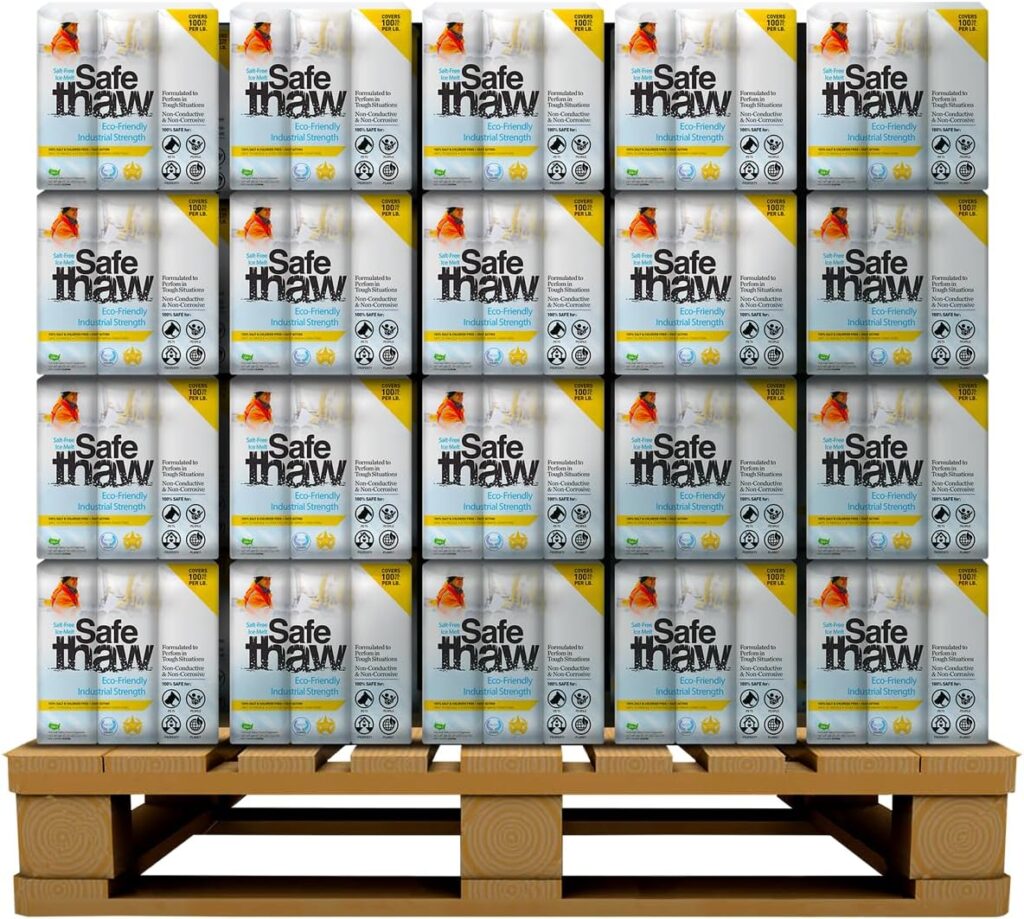
100 Boxes
Safe Thaw Industrial Strength 100% Salt/Chloride-Free, Pet/Paw-Safe Snow & Ice Melter and Traction Agent. Use on Concrete, Asphalt, Roofs & On Any Surface, 30 Pound FlexiPail- 100 Boxes
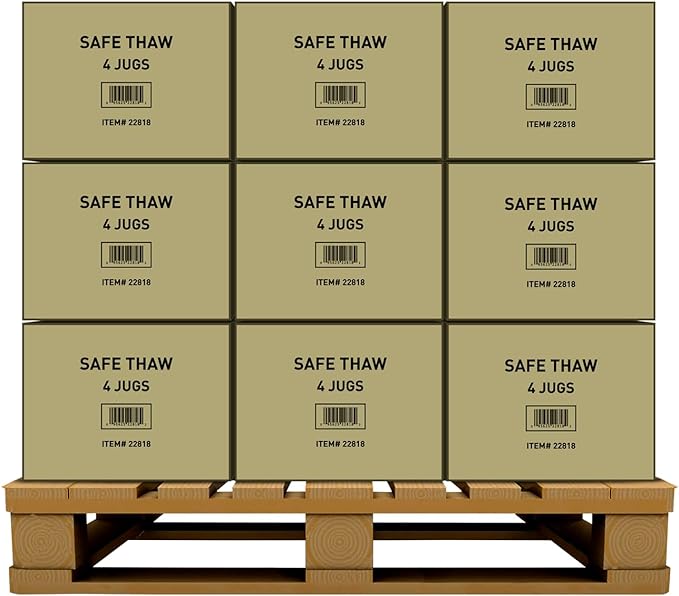
105 Jugs
Safe Thaw Concrete Safe 100% Salt-Free, Pet Safe Snow and ice Melter, Industrial Strength, Chloride-Free, and Traction Agent. Use on Asphalt, Roofs & On Any Surface, 10 Pound Jug- 105 Jugs
Addressing Costs: How Much Does a Concrete Driveway Cost?
When building or repairing a frost-proof driveway, understanding the costs involved is essential.
Initial Installation Costs
The how much does a concrete driveway cost depends on factors like size, thickness, and location. On average, a concrete driveway costs between $5 and $15 per square foot. Adding reinforcements or decorative finishes can increase costs.
Maintenance Costs
Regular maintenance, including sealing and crack repairs, is a cost-effective way to prolong the driveway’s lifespan. Budget $0.50 to $1 per square foot annually for maintenance.
Repair vs. Replacement
Repairing minor damage costs significantly less than replacing the entire driveway. For instance, resurfacing may cost $3 to $10 per square foot, whereas a full replacement can exceed $15 per square foot.
Concrete Safe Ice Melt
Safe Thaw Ice Melt is a urea-based ice melt designed to be safe for kids, pets, and the planet. Using Safe Thaw is also the best way to melt ice on sidewalk or driveways.
Safe Thaw’s non-corrosive formula can be used on concrete driveways, lawns, and decking material without discoloring or damaging the surface. And to answer your question – Can you use ice melt on your roof? Yes, definitely, Safe Thaw is completely safe and effective to use on your roof also. Safe Thaw crystal leaches out a deicing liquid and speeds up the melting process even at a temperature as low as (-25) °F. In addition, ice melting crystals prevent water from reforming to destabilize and melt ice particles in 10-minutes.
100% salt & chloride-free, fast acting Ice Management Solution
Conclusion
Building and maintaining a frost-proof concrete driveway requires careful planning, the right materials, and regular maintenance. By understanding the causes of frost heave and selecting concrete mixes designed for cold climates, you can protect your driveway from cracking and other damage.
Implementing proper drainage systems, such as sloping and French drains, minimizes water accumulation, reducing the risk of frost-related issues. Regular maintenance, including sealing cracks and applying protective coatings, ensures your driveway remains durable and attractive.
Investing in a long-lasting driveway now saves on future repair and replacement costs, making it a wise choice for homeowners in cold climates. With these tips, your concrete driveway can withstand the challenges of winter for years to come.
FAQs
Try Also Our Other Winter Safety Products:
Traction Magic
Stay safe on slippery surfaces with a product that’s 100% natural and safe for pets, people, and your property. Whether it’s sidewalks, steps, or even your car’s traction, Traction Magic is the go-to choice.
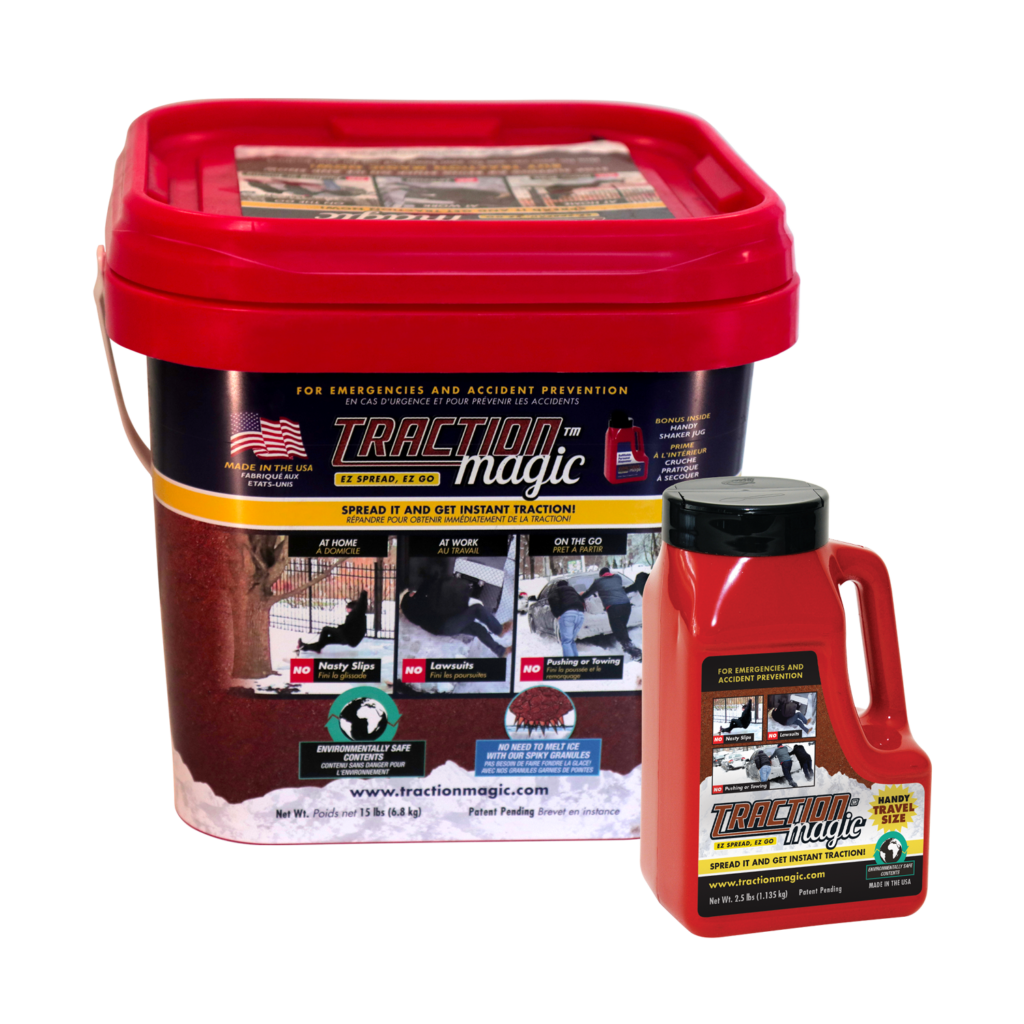
Walk On Ice
The handy disposable canister can be taken everywhere, with the same 100% naturally occurring minerals that provide instant traction on ice or snow. Use it on sidewalks, steps, or as an instant traction agent for your car.
